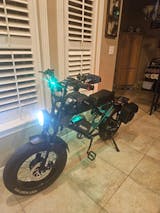Table of Contents
- 1.Assess Your Current Drivetrain
- 2.Choosing the Appropriate Components for an Upgrade
- Derailleur System Selection
- Upgrade Cassette for Gear Ratio Optimization
- Investing in Durable Ebike Chains
- Ensure Compatibility
- 3.Step-by-Step Guide to Upgrading Your Drivetrain
- 4.Common Mistakes to Avoid
- 5.Testing and Fine-Tuning to Achieve Smoother Shifting
- 6.Maintenance Tips for Long-Lasting Drivetrain
- 7.Conclusion
- 8.FAQs
A smoothly shifting ebike drivetrain makes riding more efficient and enjoyable, which is why your gears need to move smoothly without hesitation, skip, or feel rough - these could all be signs that it needs replacing soon! Over time worn components like derailleur system, chainring, and cassette may cause slow shifting which reduces pedaling efficiency by making pedaling harder or slowing pedal stroke.
Upgrades to your ebike gear optimization can improve performance, reduce wear on parts, and extend its lifespan. A well-tuned drivetrain ensures seamless power transfer when climbing steep hills or changing speed abruptly; and also minimizes chain stress to prevent early maintenance needs for your electric bicycle chain.
By investing in high-quality drivetrain components, you will enjoy smoother gear transitions, greater gear ratio balance and an overall more responsive ride experience. No matter if it be daily commutes or rugged trails - upgrading your drivetrain keeps its performance at its optimal levels.
1.Assess Your Current Drivetrain
Before upgrading, evaluate your ebike drivetrain carefully for wear. Key components like chainrings, sprockets, cassette and derailleur systems deteriorate over time, leading to poor gear shifting. A stretched chain can cause the cassette and sprockets to wear unevenly resulting in poor gear shifting performance and making shifting ineffective and rough when pedaling - this could also indicate your drivetrain needs attention if grinding or skipping noises can be heard while pedaling; signs that indicate wear in these systems can indicate this need as well.
To check ebike gear alignment, shift through all gears while spinning your pedals. If the chain struggles to shift smoothly between cogs or jumps between them, this indicates misalignment in your derailleur. Also inspect cable tension; loose cables cause delayed shifting while too tight ones may create excessive resistance.
Replacement may be necessary if a chain has worn to 0.5% (measured with a chain checker), or its teeth appear sharp or uneven, regardless of adjustments being made to it. A drivetrain upgrade could also provide the best solution if tuning remains inconsistent regardless of changes being made; regular assessments help protect against major failures, keeping performance smooth and reliable for all involved parties.
2.Choosing the Appropriate Components for an Upgrade
Upgrade your ebike drivetrain starts by choosing components with which your drivetrain works efficiently and reliably over time. Each part plays an essential part in smooth shifting and long-term performance - here are a few points to keep in mind:
Derailleur System Selection
Select a derailleur system according to your riding style. For road or commuter ebikes, short-cage derailleurs work best while long-cage derailleurs work better for mountain biking with steep climbs. Make sure it matches up with your cassette's gear ratio for optimal shifting results; using an incompatible derailleur could cause shifting issues.
Upgrade Cassette for Gear Ratio Optimization
A high-quality cassette can enhance gear performance by providing better spacing between gears. A wide-ratio cassette helps with seamless transitions over hilly terrain while for flat terrains a narrow-ratio cassette ensures precise and efficient shifting.
Investing in Durable Ebike Chains
A reinforced ebike chain reduces drivetrain wear on high torque transmissions, so when choosing an investment option look for strong corrosion-resistant chain that will protect sprockets and chainring from wear-and-tear.
Ensure Compatibility
Every component should work harmoniously together. Mismatched chainrings, sprockets, or gear indexing may cause irregular shifting and drivetrain wear, leading to unfavorable ride quality and wear on your drivetrain. Before upgrading any components be sure that your new parts match with your ebike gear tuning setup for a smooth experience.
3.Step-by-Step Guide to Upgrading Your Drivetrain
Upgrades to an ebike drivetrain can enhance shifting performance and extend component lifespan, so follow these steps for a successful upgrade:
Replacing the Chain
A worn chain causes poor gear shifting and accelerates wear on both cassette and chainring components, so a chain checker tool should be used to measure wear; once wear exceeds 0.5% it should be replaced. For durability purposes and compatibility purposes it should also match your cassette gear ratio exactly; installation should then involve threading the chain through derailleur system while cutting excess links off before installing new chain.
Installing a New Cassette
Remove the old cassette with a cassette lockring tool and install a new one using care, making sure it fits securely and snugly against its mounts. A quality cassette can improve gear performance when coupled with fresh chain - make sure that tightening up its lockring securely ensures no misalignments before reattaching your wheel.
Adjusting the Derailleur
Accurate gear tuning on an ebike helps avoid skipping and misalignment, so adjust both high and low limit screws so the derailleur moves within its proper range before fine-tuning cable tension for smooth shifts.
Fine-Tuning Gear Indexing
Use the barrel adjuster in small increments to fine tune gear indexing for crisp, consistent shifts that reduce strain on the transmission and enhance ride quality. Proper gear indexing also lowers costs by minimizing strain on transmission systems while improving rider satisfaction.
4.Common Mistakes to Avoid
Upgrading your ebike drivetrain can improve shifting, but mistakes can compromise its performance. One common misstep involves using mismatched components; using different derailleur, cassette and chainring can result in shifting feeling rough, gears skipping or faster wear and tear than anticipated - always check if new parts fit with existing setup for best results and to prevent problems down the line.
Installing an improper chain length can also be costly. Too little tension on the derailleur system leads to stiff shifting and wear on other components; too much slack leads to slow, imprecise gear changes; while having the appropriate chain size ensures smooth operation while protecting other drivetrain components.
Many riders overlook ebike transmission upgrades, assuming a drivetrain upgrade alone will suffice. But without optimizing gear ratios to suit riding conditions and underload conditions, shifting may still feel inefficient; selecting an optimal combination of sprockets and chainrings is critical for balanced performance.
Skipping routine maintenance is another common misstep, as ebike chain dirt and debris buildup increases friction, leading to faster wear, leading to longer lifespan and smoother gear shifting. By keeping the drivetrain clean, lubricated, and adjusted properly you can ensure longer lifespan as well as seamless gear shifting.
5.Testing and Fine-Tuning to Achieve Smoother Shifting
After upgrading your ebike drivetrain, testing and fine-tuning are critical in order to achieve seamless gear shifting. Begin by shifting through all gears while pedaling on a stand - each transition should feel quick and precise without hesitation or skippepping; any difficulty engaging or jumping unexpectedly means more adjustments may be required.
Cable tension imbalance is often an issue after upgrades. If shifting seems slow or unresponsive, use the barrel adjuster in small increments to tighten or loosen the cable and correct any lag in gear changes. Proper gear alignment is also key; misalignments cause noisy shifting as well as extra wear on cassette and sprockets if misalignments result in noisy shifts; make sure the derailleur sits directly under each cog when shifting for optimal results.
Final ebike gear calibration ensures consistent performance. Adjust the high and low limit screws so the chain doesn't overreach or slip off of its cassette, then take a test ride under real riding conditions with gear shifters engaged smoothly without hesitation; fine-tuning ensures longevity by reducing future shifting problems.
6.Maintenance Tips for Long-Lasting Drivetrain
A properly maintained ebike drivetrain ensures smooth gear shifting and extends the lifespan of its key components, one of which being chain maintenance. Over time, dirt and grime build-up on chains increases friction and wear on cassettes, sprockets and chainrings, leading to quicker wear on these components - hence making shifting less crisp compared with when the chain was first installed on your ride. Keeping an eye out with periodic chain checker tools will allow you to determine when replacement may be needed before it impacts performance adversely
Maintaining the entirety of an ebike's drivetrain clean and lubricated is the key to prolonging its service life and preventing premature wear and tear. Debris build-up can result in stiff links, inefficient gear engagement, and slow shifting speeds. Wiping down derailleur system, chainring, cassette with degreaser removes contaminants that hinder smooth transitions while selecting an appropriate lubricant depending on weather conditions provides protection from corrosion or wear and keeps an efficient transmission in place.
Monitoring gear misalignment is also key. If the chain begins skipping or shifting hesitates under load, take note of its calibration and cable tension settings and make necessary adjustments accordingly. Small adjustments to barrel adjuster or derailleur may restore proper alignment, thus avoiding long-term damage. Continuous maintenance keeps drivetrain reliable for smoother, more efficient ride.
7.Conclusion
Upgrading your ebike drivetrain improves gear shifting, increases efficiency, and extends the lifespan of key components. Replacing worn parts like chains, cassettes and derailleurs with new ones; calibrating gear indexing; fine-tuning indexing to create a smoother ride are all part of creating optimal operation of the transmission of an ebike transmission. Testing adjustments regularly is key to keeping it operating optimally!
An optimally tuned drivetrain delivers consistent ebike gear performance, making riding more enjoyable while relieving strain on components. Precise gear tuning enables effortless gear transitions while improving control in steep inclines or high speed rides.
Routine maintenance of an electric bicycle chain includes regular lubrication and alignment checks to ensure long-term reliability of its drivetrain, providing seamless riding experiences over many years to come. By performing regular checks, this care will keep it performing at optimal performance for years.
8.FAQs
1) How often should I replace my ebike chain to ensure smooth shifting?
To maintain smooth gear shifting, an ebike chain should be changed every 1,500-2,500 miles depending on riding conditions and maintenance needs. Regularly checking chain wear with a chain checker helps prevent damage to cassette and chainring components, while keeping it clean and lubricated can extend its lifespan and ensure seamless shifting gears.
2) Why am I still experiencing shifting issues after upgrading the drivetrain?
Even after upgrading, my ebike may still shift poorly due to improper gear indexing, cable tension or derailleur alignment. Make sure all components are compatible and correctly installed before fine-tuning ebike gear calibration with barrel adjuster/limit screw adjustments in order to eliminate hesitation, skipping or chain noise.
3) What is the ideal lubricant for an ebike drivetrain?
For optimal performance in wet or muddy conditions, use wet lubricants; for dry dusty environments use dry ones instead. A high-quality chain lube will reduce friction and wear on sprockets, cassette and chainrings by applying sparingly and wiping off excess to prevent dirt build-up ensuring your drivetrain remains running smoothly.




















